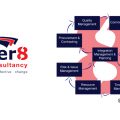Business Transition: 7 elements to success
In business, transitions take place all the time. Sometimes they can be formal affairs and other times they just ‘happen’. So what is a transition, and how do you get a business transition in shape?
Louis Pisacane takes us through the 7 key elements to ensure a business transition is successful.
Let’s start with the definition of transition. In our opinion, nothing beats the dictionary definition: ‘The process or period of changing from one state or condition to another’. Transitions then are times of change, where the ‘new state’ is taking effect and the ‘old state’ is winding down.
The immediate challenge is to make this go smoothly so there is no disruption to employees and operations. In business there are two additional challenges:
- To make sure the end state actually reflects what was intended. There are many cases of great strategies that failed. Why? Because desired or target end state was not achieved
- To ensure that while change is underway business performance is not impaired, negatively impacting customers and revenues
Here are 7 key elements to ensure a business transition is successful. This is in terms of achieving the intended or target state and how things go during this time of change:
1. Get the scope right
Get to know all the parameters of the scope, whether locations, technologies, processes, regulations, suppliers, etc. And don’t forget employees and customers as well. The focus is often on the tangible side of the scope. But, the impact on the customer, employee and their experiences is just as crucial to include in the scope. Failure to take this into account can lead to a drop in service levels. This impacts customer retention and employee morale. Then the tangible delivery of the scope must also be clearly understood by the whole business and translated to outcomes. This ensures the business clearly understands what it will be getting, when it will be transitioned, and helps to design and plan to achieve the full benefits, and avoid rework.
2. Design for the end state
Once the scope is right, the next step is to get a clear design that is understood, bought into and approved. Like the scope, the design must go beyond any technical solution and cover the processes, policies and people changes needed for the desired outcomes to be achieved.
3. Success criteria
Be clear about what success looks like. Is it timescales? Is it maintaining SLAs, customer perception, employee morale, financial performance or what combination of these? By clarifying the success criteria, the steps to the business transition can be defined in more detail and trade-offs can be made. This is important because one thing is for sure during times of change, not everyone or everything can be satisfied. In this process, third parties are also often involved and trade-offs based on agreed success criteria can ensure transitioning critical or core elements of the service at the right time to ensure the desired benefits and priorities are achieved. There are contractual mechanisms that can also be applied to ensure this, which could include bonus payments or service credits depending on the strategy. Any other features to enhance the service can then be clearly planned.
4. Design the business transition
The definition of the steps to be taken to achieve the end state are as important as the design of the end state itself. This means the same amount of due diligence should be applied in defining what the technical solution and the process, policies and people changes should look like through the transition and how they build-up to the end state. Interim outcomes can then be defined which help with communication, managing expectations and achieving benefits even while in transition. This stage is often missed in programmes because the additional cost, and the benefits, are not always tangible. But in our experience, this is a critical step in ensuring the success of a business transition. The reduction in unwanted impact more than pays for it.
5. Define your readiness controls
When steps are defined, the question is how do we make sure the steps are taken at the right time. Though target timescales are the priority of any programme, if these steps are taken before the business is ready, the disruption that can be caused if the business is not ready could be material, eroding benefits as well even customer retention and employee loyalty. This can be managed by defining go/no-go criteria that cover the solution, the service and the business readiness for the change and putting in place processes to review and take stock of what’s working, what’s not working, and therefore learn and refine the next steps. The governance around this should be made simple so that everyone involved can understand it. It can then be scheduled around key milestones or critical change points.
6. Capture the knowledge
Knowledge is critical to any business transition. As such it needs to be codified and then learned by the team that will provide the support for the new solution, process, or system. The quality of the codified knowledge and of the knowledge gained by the support team should be tested and a minimum threshold set for a ‘pass’. This can be done in various ways, including scenario tests and live trials.
7. Test every assumption
Finally, make no assumptions that are not verified as these can end up costing you. Every unverified assumption adds risk to the success of the Transition and is effectively an issue waiting to happen. There is a popular expression about what assumptions can make of ‘you and me’ that explains this perfectly. Where assumptions are difficult to verify, treat them as risks and put in place mitigations.
If you have any questions on how to get your transition to shape, get in touch.







